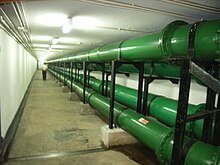Sea water air conditioning
Sea water air conditioning (SWAC), also known as ocean water cooling, is an alternative cooling system that uses the deep cold seawater as the chilling agent for a closed-loop fresh water distributed cooling system. It is one type of deep water source cooling. Once installed, SWAC systems typically operate at approximately 15% of the power consumption of conventional chillers. A SWAC system basically consists of deep seawater intake and return pipelines, titanium heat exchangers, seawater and freshwater pumps, and a distribution system for the chilled fresh water.[1]
Seawater air conditioning installations

The
Salt water air conditioning systems have been used in Sydney's Circular Quay and prominent buildings within the harbour since the rise of commercial air conditioning systems in the 1960s. These include the heritage-listed AMP 'Palm Cove' Building (constructed 1962) and the Sydney Opera House. [5][6]
The InterContinental Resort is the largest seawater air conditioning system to date, though there are several other, larger systems being planned.[7] Honolulu Seawater Air Conditioning was a project intended to use seawater air conditioning to deliver renewable cooling to commercial and residential properties in the downtown Honolulu area.[8][9] On December 19, 2020, Honolulu Seawater Air Conditioning announced it was ending its development and would end operations by the end of January 2021.[10] Honolulu Seawater Air Conditioning is majority owned by eBay founder Pierre Omidyar's Ulupono Initiative.[11]
Seawater air conditioning systems have been considered for US Naval Base Guam,[12] and for hotels near Tuamon Bay.[13]
See also
References
- ^ "Sea Water Air Conditioning" (PDF). NAVFAC Tech Data Sheet. TDS-CIOFP 1401: 1. 2013.
- doi:10.5353/th_b4257477 (inactive 2024-04-12).)
{{cite thesis}}: CS1 maint: DOI inactive as of April 2024 (link - ^ "Seawater/Lake Water Air Conditioning (SWAC/LWAC)". Ocean Thermal Energy Corporation. Archived from the original on 2020-06-07. Retrieved 2020-07-21.
- New York Times. Retrieved 2021-11-06.
- ^ "AMP Building". Sydney Living Museums. Archived from the original on 2020-06-06. Retrieved 2020-07-21.
- ^ "Lend Lease looks to Sydney Harbour for water cooling at Barangaroo". The Fifth Estate. November 20, 2012. Archived from the original on 2020-06-06. Retrieved 2020-07-21.
- ^ "The Basics of Seawater Air Conditioning Explained". YouTube. Retrieved 2020-07-21.
- ^ Lincoln, Mileka (6 August 2013). "$1M local investment in Honolulu Seawater Air Conditioning". Hawaii News Now. Archived from the original on 2020-07-21. Retrieved 2020-07-21.
- ^ Chino, Mike (2009-12-08). "Deep-Seawater Air Conditioning System to Cool Honolulu". Inhabitat. Retrieved 2021-11-06.
- ^ "Honolulu Seawater Air Conditioning to end development after 15 years". www.bizjournals.com. Retrieved 2020-12-21.
- Pacific Business News. Archivedfrom the original on 2015-03-28. Retrieved 2020-07-21.
- ^ Crisson, Kevin (2014). "Sea water air conditioning (SWAC) at Naval Base Guam: cost-beneit analysis and acquisition strategy" (PDF). The NPS Institutional Archive: Theses and Dissertations Thesis Collection. Retrieved 2021-11-06.
- ^ Makai Ocean Engineering, Inc. (2006). "A Technical and Economic Feasibility Assessment of a Deep Sea Water District Cooling System at Tumon Bay, Guam" (PDF). Guam Power Authority. Retrieved 2021-11-06.
![]() This article incorporates public domain material from NAVFAC Tech Data Sheet TDS-CIOFP 1401 (PDF). United States Navy.
This article incorporates public domain material from NAVFAC Tech Data Sheet TDS-CIOFP 1401 (PDF). United States Navy.
